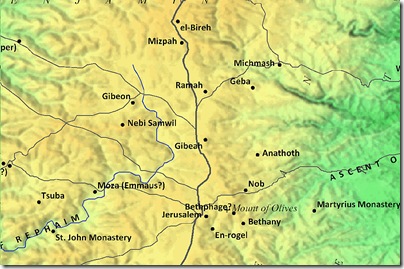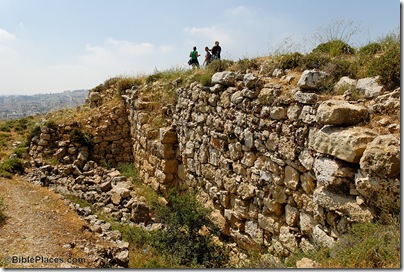The May/June issue of Biblical Archaeology Review arrived in the mail yesterday (and it’s online here), and it includes an article entitled Nebi Samwil: Where Samuel Crowned Israel’s First King.
The article is primarily a means of making public the results of the excavations at the site by Yitzhak Magen from 1992 until 2003. An article like this is to me a primary reason for the existence of BAR: it puts otherwise inaccessible material into the hands of the average Bible reader. I’ve read a summary of Magen’s report elsewhere before, but the book is very expensive and won’t be at your local library. With that commendation of the article and magazine aside, I’ll tell you why I think the central premise of the article, that Nebi Samwil is biblical Mizpah, is wrong.
The most detailed geographic passage in the Bible mentioning Mizpah is 1 Kings 15:17-22. In the story, the northern king Baasha takes Ramah away from the Judean king Asa. When Asa succeeds in getting Baasha to withdraw, Asa fortifies Geba and Mizpah. By fortifying Geba, Asa ensures that Ramah cannot be taken by the road from the east. By fortifying Mizpah (according to where nearly everyone except Magen locates it), he prevents Ramah from being retaken by the road from the north. If Mizpah is at Nebi Samwil, Asa was an idiot.
Though this story is critical to the premise, the article only deals with it in a footnote. There are two problems with Magen’s argument as presented in the footnote. First, it wrongly identifies Gibeah of Saul (= Tel el-Ful) with Geba of Benjamin (= Jaba). More importantly, it doesn’t make any sense what Asa gained by fortifying the two sites that Magen says he did (Nebi Samwil and Gibeah).
Baasha could simply come back, re-fortify Ramah, and Asa is back at square one. But if you control en-Nasbeh (Mizpah) and Jaba (Geba), you control the two main arteries into Judah from the north and prevent Baasha from returning to Ramah.

BAR has a map but it omits key data.
I made this using the free Bible Mapper.
As labeled, Gibeah=Tell el-Ful; Mizpah = Tell en-Nasbeh; Geba = Jaba
The archaeological evidence from the Iron Age at Nebi Samwil is so pathetic that it’s a wonder that Magen even tried. Knowing that you can read the whole thing yourself, I don’t mind isolating a few clips to make the point:
We did not find any remains from the time of the Judges… [that is, the time when Samuel allegedly crowned Saul here!]
Interestingly enough, we found not a single structure or even a standing wall from this period. On this basis, it might be tempting to conclude that the site was unoccupied at this time [Iron II]…. [He’s right; it is tempting…]
All this suggests caution in concluding that the site was not occupied until later. [In other words, the natural conclusion is that it wasn’t occupied until later, but we found a few scraps of evidence that should be considered.]
I commend him for his honesty, but does he really want us to assume that because he found a few Iron Age seal impressions that the site was a major military fortress in the Iron Age? We’re not idiots either. (Compare these remains with the significant Iron Age evidence at en-Nasbeh and it’s an open-shut case.)
Here’s a reality I’ve seen time and again: archaeologists often identify their site with something biblical, even if the evidence is thin. It’s a natural human response to want to be associated with something great, and if it’s archaeology in the land of Israel, a biblical connection brings lots of interest. Let’s face it: most of us wouldn’t read the article if it was all about Hellenistic buildings and a Crusader castle. But here’s what this all means to you: be careful before trusting the archaeologist when he claims the site he is excavating is mentioned in the Bible.

12 thoughts on “Nebi Samwil is not Mizpah”
Thank you so much for sharing your insight with us, Todd! As I mentioned on BAR’s website, I think it’s unsettling that he didn’t comment on the Jaazaniah seal, & cited a pre-Nasbeh-excavation article by Albright to bolster his statement that Albright didn’t think Nasbeh=Mizpah after the excavation.
You mentioned that you’ve read a summary of Dr. Magen’s report elsewhere. I’d very much like to see it–can you give me a bibliographical clue? Thanks in advance!
Magen, Y and M. Dadon.
2003 Nebi Samwil. One Land – Many Cultures; Archaeological Studies in Honour of Stanislao Loffreda. Edited by G. C. Bottini et al. Jerusalem: Franciscan Printing Press
Nice article Todd.
Let me suggest something- Maybe you are right about Iron Age Mitzpah – However maybe Nebi Samuel is the place associated with the earlier site in the time of the Hasmoneans- Its location fits nicely with Judah’s speech –
Last weekend I posted a web page highlighting points that support each of these opposing views.
For the most part, I agree with Todd; however, there are still several assumptions regarding the locations of other sites (particularly Ramah), & I’m not sure about the extent to which Magen excavated Samwil compared to the rather exhaustive excavation of Nasbeh.
One minor flaw with Todd’s perspective is that he assumes the purpose of building Mizpah & Geba was to ensure Ramah would not be recaptured, but I believe it’s possible that Mizpah & Geba could’ve been built south of the old site because the real goal might have been to block the roads leading to the south, which could’ve been accomplished under either scenario. Bear in mind that 1Kings 15:17 describes Baasha’s purpose for Ramah, not Asa’s purpose for building Mizpah & Geba.
When I read Todd’s remark saying that if Mizpah is at Nebi Samwil, Asa was an idiot, I could’ve sworn I heard Anson Rainey’s voice in my head for some strange reason! It will be interesting to see if he reacts to this BAR article, & if he’s able to reply without using the i-word.
George,
Thanks for your comments and helpful summary at your website.
Concerning your middle paragraph, it 1) demands that Geba=Gibeah=Tel el-Ful. Geba is best identified with Jaba because of its close association with Michmash (Mukmas) in the Bible; 2) doesn’t explain why Asa would gain anything by fortifying sites south of Ramah. He could have fortified those sites before or during Baasha’s possession of Ramah, but that didn’t solve his siege problem. And fortifying them afterwards would not prevent Baasha from returning to Ramah and reimposing the siege again.
From what you can see at Nebi Samwil, it seems that the site was excavated pretty thoroughly. So unless one assumes that the Iron Age city was somewhere down the slope, I don’t think there was one there. That itself is interesting, given the natural geographical advantages of the site.
Yes, like I said, I agree with the consensus view about Jaba & Mukmas, but I’m not willing to say the case is closed because the identification of those sites is still, to a certain degree, speculative. Michmash depends on Beth El, & even that site’s been disputed.
Regarding the explanation for why Asa would gain anything by fortifying sites south of Ramah…
The point is that Samwil was near a major road coming from the east, & Ramah was near a major road coming from the north. By controlling these 2 roads, Asa would gain control of those routes, & be able to confront armies advancing on Jerusalem from those directions. The point is not that he was preventing the rebuilding of Ramah, but that he was using “free” building supplies from Ramah (courtesy of Baasha) to build up 2 strategic sites. Yes, he could have fortified those sites before or during Baasha’s possession of Ramah, but he would not have gotten the building materials for free, & with Baasha’s attention turned much farther north, Asa had time to strip Ramah & build those other 2 sites.
So in other words, “Feel free to come back & rebuild Ramah, Baasha! We’re not afraid of you now that we’ve fortified 2 strategic sites between there & Jerusalem at your expense!”
I think that you’re thinking too much like an American, valuing free goods over security. I don’t think that’s the point of the story, but we can disagree.
I don’t think that there’s any question about Michmash however. Besides the name preservation in Mukmas, it’s immediately adjacent to “the pass,” which is a fixed geographical feature. That too helps to fix Geba at Jaba (read Isaiah 10:28-32).
For thinking like an American, I’m definitely guilty as charged. But what would you accuse Yitzhak Magen of? Surely he knows West Bank geography as well as you.
You & I don’t disagree on the interpretation of the Biblical record pertaining to Mizpah; I’m merely pointing out the possible validity of Dr. Magen’s interpretation (which, even if he’s correct & you’re wrong, wouldn’t have a negative impact on God’s holy Word; it would just be another example of a Biblical person doing something stupid–like as if we don’t already have plenty of great examples!).
It would’ve been nice to hear you admit that it’s possible, but if you don’t believe there’s any chance that he’s right, essentially believing that he’s completely wrong, then I still admire you for taking a firm stand.
(Bear in mind that I’m being as kind as possible to Dr. Magen because I’m hoping he’ll eventually provide me better photos of the jar handles–one of them is an extremely rare type!)
What I “accused” Magen of was over-emphasizing the evidence that gave his site a biblical name. I think that he, as an archaeologist, should have ruled NS out solely on the basis of the lack of Iron Age remains.
I certainly don’t mind the debate. Looking carefully at the evidence is essential to coming to right conclusions, and revising long-held, but inaccurate, ones.
In my opinion, I have not seen evidence that would allow me to say that it is *possible* that NS was Mizpah in the Iron Age (1200-600 B.C.). I would not rule such an identification out for later periods, but I have not examined the evidence carefully for that.
I hope that you get your photos!
For those interested in this controversial but esoteric subject, Dr. Aaron Brody posted an interesting compromising proposal to BAR’s article page today. Ultimately, we’ll need to hear from Jeff Zorn too.
I've already written a brief response to Magen which appeared in BAR. http://www.bib-arch.org/bar/extra.asp?ArticleID=12
Those who want to read more about my work on Tell en-Nasbeh are invited to visit http://www.arts.cornell.edu/jrz3/pdf_files_of_collected_works.htm
Jeff Zorn